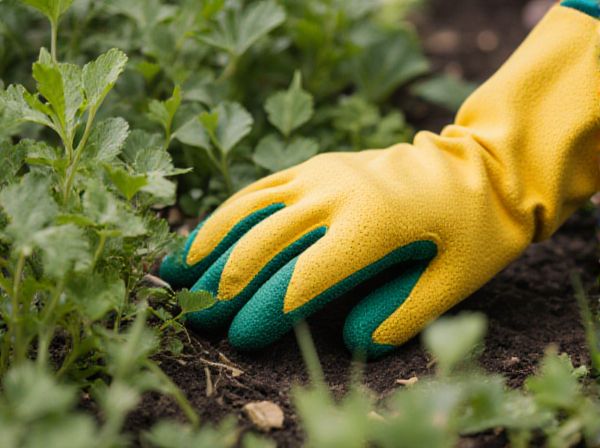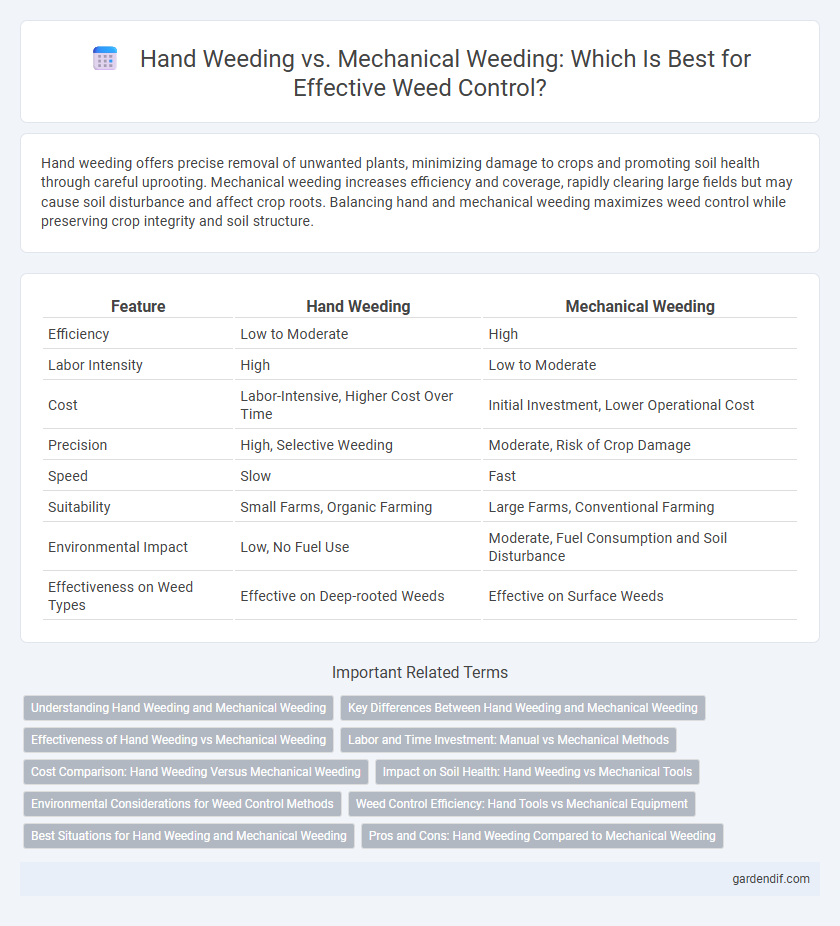
Hand weeding vs mechanical weeding Illustration
Hand weeding offers precise removal of unwanted plants, minimizing damage to crops and promoting soil health through careful uprooting. Mechanical weeding increases efficiency and coverage, rapidly clearing large fields but may cause soil disturbance and affect crop roots. Balancing hand and mechanical weeding maximizes weed control while preserving crop integrity and soil structure.
Table of Comparison
| Feature | Hand Weeding | Mechanical Weeding |
|---|---|---|
| Efficiency | Low to Moderate | High |
| Labor Intensity | High | Low to Moderate |
| Cost | Labor-Intensive, Higher Cost Over Time | Initial Investment, Lower Operational Cost |
| Precision | High, Selective Weeding | Moderate, Risk of Crop Damage |
| Speed | Slow | Fast |
| Suitability | Small Farms, Organic Farming | Large Farms, Conventional Farming |
| Environmental Impact | Low, No Fuel Use | Moderate, Fuel Consumption and Soil Disturbance |
| Effectiveness on Weed Types | Effective on Deep-rooted Weeds | Effective on Surface Weeds |
Understanding Hand Weeding and Mechanical Weeding
Hand weeding involves manually removing weeds by pulling them from the soil, allowing for precise control and minimal damage to crops. Mechanical weeding uses specialized equipment such as cultivators or robotic weeders to disrupt weed growth efficiently across large areas. Understanding the differences in labor intensity, cost, and environmental impact between these methods helps optimize weed management strategies.
Key Differences Between Hand Weeding and Mechanical Weeding
Hand weeding offers precise removal of weeds with minimal soil disturbance, making it ideal for small-scale or delicate crops, whereas mechanical weeding provides faster coverage of large fields but may cause soil compaction and damage to young plants. Labor intensity and cost are significant factors; hand weeding requires more manual labor and time, while mechanical weeding involves higher initial investment but reduces long-term labor expenses. Effectiveness varies with weed type and growth stage--hand weeding excels in targeting specific weeds, whereas mechanical methods are suited for broadleaf weeds and early growth stages.
Effectiveness of Hand Weeding vs Mechanical Weeding
Hand weeding offers precise removal of weeds, minimizing damage to crops and preserving soil structure, which enhances effectiveness in small-scale or delicate farming systems. Mechanical weeding, while less selective, covers larger areas quickly and reduces labor costs, proving more effective in extensive agricultural operations. Effectiveness depends on crop type, scale, and weed density, with hand weeding excelling in targeted control and mechanical methods optimizing speed and efficiency.
Labor and Time Investment: Manual vs Mechanical Methods
Hand weeding demands significant labor intensity and longer time investment due to the meticulous physical effort required to remove weeds individually. Mechanical weeding significantly reduces labor costs and time as machines cover larger areas quickly, offering efficiency particularly in large-scale farming operations. However, mechanical methods may involve high initial equipment costs and maintenance, impacting overall economic feasibility.
Cost Comparison: Hand Weeding Versus Mechanical Weeding
Hand weeding requires significantly higher labor costs compared to mechanical weeding, with manual efforts demanding intensive hours and skilled labor that increase operational expenses. Mechanical weeding, while involving upfront investment in equipment purchase and maintenance, reduces long-term labor costs and improves efficiency in larger fields. Cost analysis reveals that for small-scale farms, hand weeding may be economically feasible, but for extensive agricultural operations, mechanical weeding offers superior cost-effectiveness and scalability.
Impact on Soil Health: Hand Weeding vs Mechanical Tools
Hand weeding preserves soil structure by minimizing disruption to soil aggregates and maintaining beneficial microbial activity. Mechanical weeding tools, while efficient in weed removal, often disturb the soil surface, leading to increased erosion risk and reduced organic matter content. Selecting hand weeding supports long-term soil health and biodiversity, whereas mechanical methods may degrade soil quality if used excessively.
Environmental Considerations for Weed Control Methods
Hand weeding reduces chemical use, minimizing soil and water contamination, and promotes biodiversity by preserving beneficial insects and microorganisms. Mechanical weeding disturbs the soil structure, potentially increasing erosion and carbon release, but can be effective in larger-scale operations where manual labor is impractical. Both methods influence energy consumption and greenhouse gas emissions differently, with hand weeding requiring more human labor and mechanical weeding relying on fossil fuel-powered equipment.
Weed Control Efficiency: Hand Tools vs Mechanical Equipment
Hand weeding provides precise control by targeting individual weeds, making it effective in small-scale or delicate crops, but it is labor-intensive and time-consuming. Mechanical weeding equipment covers larger areas quickly and can manage weed populations efficiently, though it may lack the precision of hand tools and sometimes disturb crops or soil structure. Weed control efficiency depends on scale, crop type, labor availability, and the specific weed species present in the field.
Best Situations for Hand Weeding and Mechanical Weeding
Hand weeding is ideal for small gardens, delicate crops, and areas with dense weed growth where precision is crucial to avoid crop damage. Mechanical weeding suits large-scale farms with row crops, where machinery can efficiently cover extensive areas and reduce labor costs. Choosing between the two depends on factors such as crop type, field size, and weed density to optimize weed management and crop health.
Pros and Cons: Hand Weeding Compared to Mechanical Weeding
Hand weeding offers precise removal of weeds with minimal soil disturbance, making it ideal for small-scale or organic farming, but it is labor-intensive and time-consuming. Mechanical weeding accelerates the process and covers large areas efficiently, yet it may damage crops and disrupt soil structure. Choosing between hand and mechanical weeding depends on factors such as farm size, crop sensitivity, labor availability, and sustainability goals.
Hand weeding vs mechanical weeding Infographic

 gardendif.com
gardendif.com